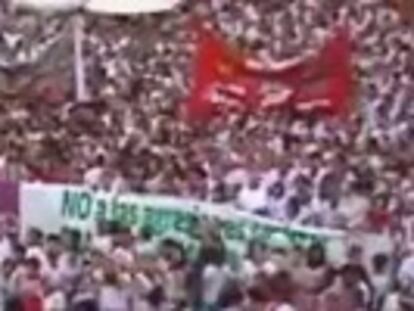Pro-Obama astronauts and political protest as Sanfermines kick off
World-famous Running of the Bulls gets started in Pamplona with some unusual and unexpected guests

The traditional “Chupinazo” – a firework rocket launched at midday from a balcony in Pamplona City Hall – inaugurated Spain’s world-famous Sanfermines on Wednesday.
The Running of the Bulls, as the fiesta is known in the English-speaking world, has attracted thousands of revelers for 204 uninterrupted hours of scheduled events between today and July 14. The northern Spanish city has spent €1.95 million on cultural programming, public restrooms and personnel alone, representing a 3.5% rise from 2015.
Safety concerns
Aware of last year's reports of sexual harassment, Sanfermines organizers are striving for a clean record this year. Armando Cuenca, spokesman for the leftist group Aranzadi at the local council, expressed hope that "people will have a good time, enjoy themselves calmly and remember that no means no."
The city is also planning to hand out 4,000 bracelets for parents to put on their children with a telephone number to call in the event that they should be separated in the crowd.
The Red Cross reported it had assisted nine people with minor injuries in the first hours of the Sanfermines celebrations.
As noon approached, thousands of people jammed the main square, wearing wine-drenched shirts that had once been white and waving red neckerchiefs traditionally worn at this time of the year. Local and regional officials were on hand to watch Jesús Ilundáin Zaragüeta – the man who promoted the popular chant used by runners before each morning race – light the fuse and pronounce the legendary words that officially open the festival: “Pamplonesas, pamploneses, ¡Viva San Fermín! Iruindarrak, ¡Gora San Fermín!”
Zaragüeta, a popular local figure better known as El Tuli, had words for those who could not be there. “I am sorry for them, they must be suffering and crying right now,” he stated.
Welcome, Mr Obama
An individual dressed up as an astronaut also figured prominently at the celebration. Appearing in one of the balconies at town hall, right under the clock, five minutes before noon, this person held up a sign welcoming US President Barack Obama.
The sign, written in English, welcomed Mr Obama to the “rebel town” of Pamplona, and may be related to the US president’s trip to Spain, which is scheduled for July 9.
Political statement
But despite the show of shared enjoyment, political controversy was not far from the surface. Mayor Joseba Asiron, of the radical coalition Euskal Herria Bildu, noted that the fact that the Basque flag did not hang from city hall meant that “all sensibilities are not represented.”
Although Navarre is not formally part of the Basque Country – it is a separate region in its own right – there are shared historical ties, and pro-independence groups have long defended a union of all Basque-speaking regions.
Under Navarrese laws, the only flags that may officially be flown are those of the municipality, of Navarre itself, and of the European Union – but not the ikurriña, which is official only to the nearby Basque Country.
Some people in the crowd made up for the omission by displaying large Basque flags of their own outside city hall.
“We want to convey that there is a wealth, a plurality of sentiment in Pamplona that should be represented at San Fermín more than at any other time,” said the mayor.
Deputy Mayor Joxe Abaurrea added that “I believe that even [conservative party] UPN shares the feeling that this is a plural city, a city with two languages, with different beliefs, and we need coexistence.”
Tu suscripción se está usando en otro dispositivo
¿Quieres añadir otro usuario a tu suscripción?
Si continúas leyendo en este dispositivo, no se podrá leer en el otro.
FlechaTu suscripción se está usando en otro dispositivo y solo puedes acceder a EL PAÍS desde un dispositivo a la vez.
Si quieres compartir tu cuenta, cambia tu suscripción a la modalidad Premium, así podrás añadir otro usuario. Cada uno accederá con su propia cuenta de email, lo que os permitirá personalizar vuestra experiencia en EL PAÍS.
¿Tienes una suscripción de empresa? Accede aquí para contratar más cuentas.
En el caso de no saber quién está usando tu cuenta, te recomendamos cambiar tu contraseña aquí.
Si decides continuar compartiendo tu cuenta, este mensaje se mostrará en tu dispositivo y en el de la otra persona que está usando tu cuenta de forma indefinida, afectando a tu experiencia de lectura. Puedes consultar aquí los términos y condiciones de la suscripción digital.
More information
Archived In
Últimas noticias
Most viewed
- Sinaloa Cartel war is taking its toll on Los Chapitos
- Oona Chaplin: ‘I told James Cameron that I was living in a treehouse and starting a permaculture project with a friend’
- Reinhard Genzel, Nobel laureate in physics: ‘One-minute videos will never give you the truth’
- Why the price of coffee has skyrocketed: from Brazilian plantations to specialty coffee houses
- Silver prices are going crazy: This is what’s fueling the rally










































